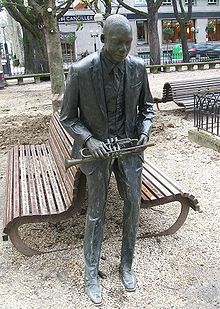| Papa Celestin’s band Circa 1927 |
As winter break set in I had time to watch some movies and shows on Netflix. One of the shows was the Ken Burns documentary Jazz. As I was watching it I listened carefully to the language used to describe Jazz especially by Wynton Marsalis. They describe what can only be creativity. Not "inspiration" but perspiration born out of practice, deep understanding of the craft, and the license to experiment. In essence the quintessential 21st century learning experience was created over a hundred years ago. Down in New Orleans musicians from all walks of life created a genre of music that allows all of its participants to be constantly engaged with creation and recreation. In many ways Jazz is a great metaphor for 21st century learning.
.jpg) |
| Thelonious Monk 1947 |
- Creativity. Jazz requires creativity from all. Not just composers but players and even the audience.
- Collaboration. Jazz is inherently at once a collaborative and highly individualistic endeavor. Musicians sit together and collaborate to create an experience for themselves and audiences. They must take turns, lead, and follow.
- Experimentation. For Jazz to succeed there must be room to experiment and fail (often to be saved by your fellow musicians- so I am told).
- Communication. Musicians must communicate with each other to take turns, solve problems and create a cohesive sound, not an easy feat while improvising. They also must be able to communicate verbally and musically with their audience.
- Subject Matter. This creativity and effective collaboration happens as musicians master their instruments. There is a threshold of understanding of music and of a specific instrument before the rest can come into play in meaningful ways.
- Diversity. Jazz was also born out the meeting of many cultures led by African Americans and later Creoles. It shows how important diversity of culture, language and experience are. And how they can make something new, original and wonderful that has survived the test of time. When we argue for diversity in our schools, universities, and places of work, we should keep Jazz as a shining example of the possible.
- Technology. The spread of Jazz was aided to a great degree by the information technology of its age. First the gramophone and then radio that became the great equalizer like the internet does now.

Wynton Marsalis reflects:
"Well, we have to realize that just like in New Orleans, a, a band
would march down the street; everybody heard the music. Buddy Bolden’s open this trumpet up. If you were white, green, red, it didn’t make a difference. You were going to hear some swinging jazz music. If you played trumpet, you wanted to play like him. The radio did that in an ad… The radio did that nationally. Now, you could be in Dubuque, and you could hear somebody playing in a ballroom somewhere in New York, many times, you, you didn’t know whether the band was black or white. All you knew was, Man, whatever this is, I want to get a part of this. And the radio did a lot to break down segregation. In fact, even though the laws remained, in fact those m…, tho…, the, in fact, people all around the United States of America were listening to the mind and the soul of the Afro-American unguarded.
They could really check out the music of Duke Ellington, the music of Count Basie."(full transcript here)
Wynton points out the ability of technology to break down barriers, serve as a voice that is more democratic, more human, transcending some of the stereotypes generated by time and place.
So, Jazz can be a great metaphor, or maybe just maybe it can be part of a 21st century curriculum. A kind of learning that really goes to the uncommon core that can make our students truly creative, collaborative, and embracing diversity.